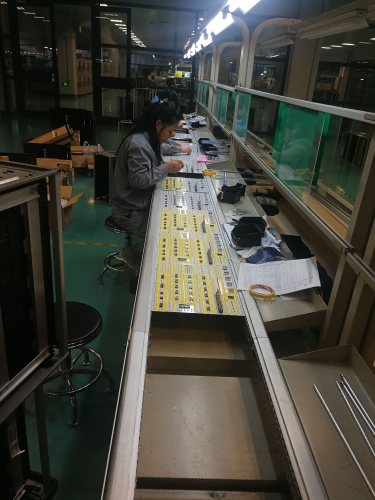Product description:
This experiment box is a self-control/counter control two-in-one teaching experiment system. It adopts modular structure and can construct various types and orders of analog links and control systems. It can also carry out experimental teaching of computer control technology with microcomputer as the control platform, so as to achieve multi-purpose. System composition
1. Power supply:
Input single-phase three-wire ~ 220V ± 10% 50Hz. Output DC 5/2A, ±12V/0.5A power supply, with reverse and short circuit protection. 2. Core system:
It adopts 8088 microprocessor to facilitate computer control technology software programming;
RS232 bus interface communicates with host computer (which can communicate with USB interface); it contains upper computer total clear reset and manual total clear reset circuits;
including automatic lock zero and manual lock zero function. 3. Function generator:
The experimental box comes with signal measurement and signal display module, which can measure signal voltage (-5V ~ +5V), frequency, temperature, speed and other parameters. 4. Step signal generator:
It is generated by manual step (0/+5v, -5v/+5v), amplitude control (potentiometer), and nonlinear output group.
5. Function signal generator:
It can output sine wave, oblique wave, square wave, rectangular wave, relay characteristics, saturation characteristics, dead zone characteristics and gap characteristics. It has switch
switching and digital tube displays waveform related information. The sine wave signal frequency range is 0.1HZ~2HZ and 0.8HZ ~ 50HZ, the resolution is 0.1HZ and 1HZ. The other waveform frequency range is 0.1HZ~250HZ, and the resolution is 0.1HZ. The amplitude range
of the waveform signal is -6V~+6V, the amplitude resolution is 0.1V, and the distortion is no more than 0.5%, the impedance is no more than 50Ω. 6. Operational simulation unit:
Provides 8pcs OP07 basic operational amplifier analog units (for experiment), each unit's input loop has 6 sets of 0.5% precision resistors, or 5% precision capacitors, and the feedback loop has 7 sets of 0.5% precision resistors, or 5% precision capacitors, and one operational amplifier is composed. Another extended operational amplifier analog unit, one is variable null amplifier, constitutes proportional link, inertia link, integral link, proportional differential link, PID link and typical second-order, third-order system, etc.; the second is correction network library, it can form various correction links; the third is two sets of shaping modules.

7. Provide resistance-capacitance element library:
250K and 500K potentiometers, 2 sets of 0-999.9K direct-reading variable resistors, multiple sets of capacitors.
8. 1 set of D/A output:
Voltage: 0~5V or –5V~+5V
9. 4-channel A/D input:
There are two channels with 0~+5v voltage input and two channels with -5v~+5v voltage input.
10. 2 sets of sample holders and one-shot unit circuits
11. Provide precision reference voltages +Vref and -Vref
12. Timing and Interrupt Unit:
2 sets of timer counters and two-way interrupt sources. 13. Provide virtual oscilloscope:
1) 2 channels of analog signal input: It can measure phase plane display, frequency domain logarithmic amplitude frequency, phase frequency curve, amplitude phase curve, etc.
2) Time domain display mode of oscilloscope: Phase plane display (X-Y) mode of oscilloscope;
frequency characteristic display mode of oscilloscope includes logarithmic amplitude frequency characteristic display, logarithmic phase frequency characteristic display (Bode diagram), amplitude phase characteristic display mode (Nyquist diagram), time domain analysis (radian) display mode.
3) The computer controlled display mode of the oscilloscope.
14. Peripheral control object:
1) Stepping motor (35BY48) speed and angle control.
2) DC motor (BY25) pulse speed output and voltage speed output.
3) Temperature module adjustable pulse width input control and voltage input control heating, thermistor temperature measurement (0℃ ~ 76.5℃).
15. Support secondary development:
In addition to the analog operation unit and function generator, the 8253 timer, 8259 interrupt controller, analog-to-digital converter, and the digital-to-analog converter address of the experimental box are also open to the user.
16. Experimental box:
Adopts aluminum-aluminum alloy material, reference size: 480 × 360 × 100mm.
Training courses:
Automatic control experiment
1. Time domain analysis of linear system:
1) Simulation study of typical links
2) Second-order system transient response and stability
3) Third-order system transient response and stability
2. Frequency domain analysis of linear control system (Bode diagram, Ness diagram):
1) Frequency characteristic curve of inertial link
2) Frequency characteristic curve of second-order closed-loop system
3) Frequency characteristic curve of second-order open-loop system
4) Time domain analysis of frequency characteristics
3. Phase plane analysis of nonlinear system:
1) Typical nonlinear links
2) Second-order nonlinear control system
3) Third-order nonlinear control system
4. Calibration and status feedback for linear system:
1) Correction of linear system
①Frequency domain method series lead correction
②Time domain method series proportional differential correction
③Time domain method proportional feedback correction
④Time domain method differential feedback correction
2) State feedback and pole placement of linear system
5. Sampling control system analysis
6. Simulating DC motor closed-loop speed regulation experiment
7. Simulating temperature closed loop control experiment
Computer control technology experiment
1. Digital/analog conversion experiment
2. Analog/digital conversion experiment
3. Sampling and holding:
1) Sampling experiment
2) Sampling/holder experiment
3) Sampling/holding control system analysis example
4. Smoothing and digital filtering experiment:
1) Differential and smooth
2) Digital filtering
5. Digital PID Control Experiment:
1) Standard PID control algorithm
2) Integral separation PID control algorithm
3) Nonlinear PID control algorithm
4) Integral separation--Bang-Bang compound PID control algorithm
6. Minimum beat control system:
1) Minimum beat ripple system
2) Minimum beat ripple-free design
3) Minimum beat control system design example
7. Dalin algorithm:
1) Dalin algorithm with obvious ringing phenomenon and ringing elimination
2) Dalin algorithm with weak ringing and ringing elimination
3) Dalin algorithm without ringing
8. Multivariable decoupling control:
1) Multivariable decoupling control design
2) Multivariable decoupling control design
9. Secondary development of microcomputer control
Control system experiment
1. DC motor closed-loop speed regulation experiment
2. Temperature closed loop control experiment
3. Stepper motor speed control experiment
4. Analog/digital mixed temperature closed-loop control experiment


